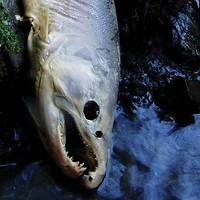News Blog

- Photo Courtesy of Bureau of Reclamation
- Lewiston Dam
After initially refusing to release additional water from Lewiston Dam into the Trinity, and by turn the Klamath, the bureau reversed course last month after dire warnings from biologists and local tribes that conditions in the lower Klamath River were eerily similar to 2002, when more than 50,000 salmon died of gill rot as flows in the river dwindled and water temperatures increased. But biologists worried the releases came too late, and this week reported finding a significant number of salmon infected with parasites.
In response, the bureau has begun releasing additional emergency flows into the river systems, hoping more water will flush the parasites out to sea and create more space for the fish to circulate. Fish already infected with the parasite will likely die, but the hope is that the extra flows will keep additional salmon from becoming infected.
In response to today’s releases, the Yurok Tribe issued a press release praising the federal agency’s quick action.
“While there has not been a confirmation that any fish have died as a result of (the parasite), we are extremely concerned that there could be another fish kill in the coming weeks if additional flows are not released,” Yurok Tribal Chairman Thomas O’Rourke Sr. said in the release. “We appreciate that the Bureau of Reclamation heeded our request to send emergency flows down the Klamath River.”
As with prior releases of additional water, the public is warned to take caution around the rivers, as they will be running faster, fuller and colder than usual.
See the tribe’s full press release below, followed by one from the Hoopa Valley Tribe warning of dire conditions:
At the Tribe’s Request, the BOR is sending emergency flows down the KlamathFrom the Hoopa Valley Tribe:
Tribal biologists find Ich, the pathogen responsible for the 2002 fish, for the first time in 11 years
Today, following the discovery of a significant number of salmon infected with the deadly parasite Ichthyophthirius multifiliis or Ich and at the request of the Yurok Tribe, emergency flows will be sent down the Klamath River.
On Monday, September 15, the Yurok Fisheries Program, along with the U.S Fish and Wildlife Service’s California-Nevada Fish Health Center examined several Klamath River Chinook salmon and confirmed the presence of the deadly parasite, which was responsible for the 2002 fish kill.
Ich was found in 11 of the 26 fish that the Yurok Fisheries Program sampled yesterday. Six of the salmon were severely infected with the ciliated protozoan parasite. This is the first time Ich has been detected since the Yurok Fisheries Program began monitoring for it in 2003, following the 2002 fish kill The prevalence of Ich exceeded a threshold identified by USFWS/NMFS during 2013 for releasing emergency flows to prevent a major disease outbreak. BOR’s decision today to double the flow in the Lower Klamath will help minimize the risk of a major fish kill.
“While there has not been a confirmation that any fish have died as a result of Ich, we are extremely concerned that there could be another fish kill in the coming weeks if additional flows are not released. We appreciate that the Bureau of Reclamation heeded our request to send emergency flows down the Klamath River,” said Thomas P. O’Rourke Sr.
If the additional flows were not released back in August, it is highly likely there would have already been a massive fish kill on the Klamath River.
Last Friday, the Yurok Fisheries Program hand-delivered slides, made from imprints of the gills of salmon believed to be sickened by Ich, to the USFWS Fish Health Center in Anderson, Ca. Over the weekend Fisheries crews continued to collect fish, many of which later tested positive Ich. On Monday, the Fisheries Program and Dr. Scott Foote from the center examined the 26 fish for Ich.
“This quick response from the BOR and USFWS Fish Health Center will greatly lessen the chance of another fish kill,” Chairman O’Rourke said.
The Yurok Tribe will continue to monitor fish health in the Lower Klamath River until the fall run has subsided.
Ich outbreaks are the result of a combination of three factors, which consist of low flows, warm water and high fish densities. The Klamath River Basin is suffering through three years of extreme drought and is seeing a larger than predicted run of salmon in a relatively low flowing river.
Prior to this year’s fall run of Chinook salmon, the Yurok Tribe, anticipating unhealthy river conditions that could trigger a fish kill, submitted two formal request to the Secretary of Interior asking that additional flows be sent down the Klamath River from August 26 to September 21. Originally, the BOR declined to implement the Yurok Tribe’s proposal for additional flows to lessen the likelihood of another fish kill. At the Yurok Tribe’s request, the BOR reconsidered its decision to not provide these additional flows from August 23 – mid-September to protect fish.
“We are glad that BOR reconsidered our request and most likely the earlier releases prevented a large-scale fish kill similar to what took place on the Yurok Reservation in 2002” Chairman O’Rourke said.
Based on the observations of Yurok fisheries biologists and tribal fishers, it is likely that this year’s run of Chinook salmon was substantially under predicted. During crowded conditions, such as during a large escapement year, Ich is more readily passed from one fish to the next. In order to reduce fish densities and the chance of another catastrophic fish kill, the Yurok Tribe plans reopen the subsistence fishery for two weeks, with a 2-day closure each week for the protection of Coho.
The Hoopa Valley Tribe took swift action responding to the Klamath River fish kill and contacted the Bureau of Reclamation Regional Director, Dave Murillo. A potentially catastrophic outbreak of disease among fall Chinook salmon has today commenced in the lower Klamath River. Samples examined by Dr. Scott Foott show infection with ich of at least nine fish, including six with “severe” infestations.
Consequently, an emergency doubling of flows at the USGS “KNK’ gage from pre-existing levels for a period of 7 consecutive days, will be required in an attempt to avoid a massive fish kill. They asked Mr. Murillo to please take action immediately to release emergency flows. Our leadership is currently in discussion with Mr. Murillo on the proposed action.
Chairwoman Danielle Vigil-Masten stated that, “The Hoopa Valley Tribe is very appreciative of the earlier action that Reclamation took by releasing preventative flows. We are in another stage that we did not anticipate and we shouldn’t deviate from what the science tells us to do. We expect that Reclamation will take the right action which is to release the emergency flows that are called for under the criteria.”
Dr. Scott Foott, a pathologist with the U.S. Fish and Wildlife Service, discovered severe ich (ichthyophthirius multifiliis) infestations in fall run Chinook salmon taken from the Lower Klamath River.
Massive ich infestations among overcrowded fish led to a massive fish die-off in 2002, which left tens of thousands of fish dead and dying along the Klamath and Trinity Rivers.
Robert Franklin, senior hydrologist with Hoopa Tribal Fisheries, said, “The fear is that all the fish might die in the Lower Klamath like they did in 2002.”
This year, like in 2002, massive amounts of water have been diverted from the Klamath and Trinity Rivers to agricultural users hit by severe drought, leaving only a small portion of the rivers’ natural flows to sustain their ecosystems.
As more water is diverted away from local rivers, lower water flow leads to higher temperatures in the water, and diseases and parasites spread among fish crowded into the few deep pools along the river.
Franklin said only an immediate doubling of flows on the Trinity could prevent the infection from spreading rapidly. “It needs to take place immediately because the water will take several days to reach the Lower Klamath.”
Hoopa Valley Tribal Chairwoman Danielle Vigil-Masten requested this afternoon that the Bureau of Reclamation immediately double the flows released into the Trinity from Lewiston Dam.
“We expect that the Bureau of Reclamation will take the right action and release the emergency flows that are called for,” Vigil-Masten said.

Comments